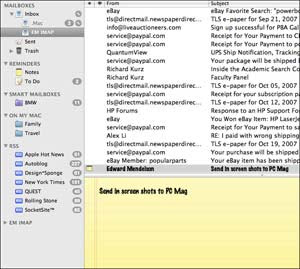Apple's new OS
Apple's upgraded Leopard operating system debuted this week as trend-setting iPods and iPhones cause the ranks of Macintosh computer lovers to swell.
Eagerly-awaited by Apple's notoriously cultish followers, Leopard's release was delayed so the company's engineers could devote their time to getting iPhones to market in the United States in June.
Rival Microsoft, whose software powers 90 per cent of the world's computers, released its own new operating system, Vista, in January.
Time Machine
Leopard features include playful “iChat” video-conferencing and a “Time Machine” that resurrects lost data. The 3D Time Machine was inspired by a survey that indicated only 26 per cent of Macintosh users regularly backed up information on their machines to avoid losing it forever in system crashes.
The feature automatically copies music, pictures, applications, files and “absolutely everything” a person puts on their Macintosh, according to Apple vice president of platform experience Scott Forstall.
The operating system enables people to remotely search for files on all computers connected to their network. In the event a file is lost, users can search back through time to find deleted files, applications, photos and other digital media and then instantly restore the file. If required, Leopard can also restore an entire system from the Time Machine data on an external drive.
Widgets
Leopard also has simple tools for people to create “widget” applications that stream feeds such as news or syndicated cartoons from websites onto small windows on computer screens.
It includes improved text-reading, Braille support and closed-captioning for people with disabilities. There's also a dictionary with Wikipedia built in, allowing users to access up-to-date information on any subject.
iChat Theatre
Modifications to iChat allow people linked via Web cameras to share slide show presentations, playfully distort their pictures or insert fake backdrops.
iChat Theater makes it easy to show photos, presentations, videos or files in a video conference; screen sharing which lets users remotely view and operate another Mac; and Photo Booth effects for fun distortions and video backdrops that can instantly make users appear to be anywhere they choose.
Stack-up
Another useful addition to Leopard is Stacks. It is a virtual “stack” of documents that lives in the dock area, giving users one-click access to files.
They can create their own Stack, when a user clicks on it, the Stack will display all the documents in a cascading pile. Downloads too are automatically added to the download Stack to help the user find them easily.
Mail goes new
The new OS also packs some new features in its email programme. There's Data detection software that will spot key words in messages, such as appointments, dates and times.
On running the cursor over these details and it will ask the user if he wants to add them to his calendar application as an event. Not only this, if it senses an address, it will even generate a Google Map. There are also additions like sticky notes and to-do lists.
Parental Controls
Microsoft's Vista boasted it, so how could Apple be behind. Under Leopard's Parental Controls panel, if a user sets up multiple user accounts, including individual ones for children, he can manage and control the amount of time they can spend online (including different allowances for weekends and school nights) and the kind of websites they are allowed to access.
It also has content filters to weed out inappropriate content and activity logging to monitor their web use.
Embraces Microsoft
Crucially, Leopard is the first Apple operating system that will also allow you to install a Windows operating system alongside it. The BootCamp programme has been available for download on some other Apple machines, but it required a level of technical expertise to install and run that some novice users may have found daunting.
In Leopard, it's all built in: you just need to buy a copy of Windows and let the BootCamp assistant guide you through the installation process.
Google Desktop
Google Desktop for Mac has been updated adding support for the new Mac OS X 10.5 Leopard.
In addition to Leopard support, Google Desktop allows indexing of drives where Spotlight has been disabled Desktop no longer tries to index PGP disks; Time Machine won't back up Desktop indexes, nor will Desktop search Time Machine backups; and Desktop preferences pane now supports keyword searching in System Preferences for various settings.
Wednesday, November 28, 2007
Apple's new OS
Posted by
zameer
at
1:28 AM
![]()
Subscribe to:
Post Comments (Atom)
Web Stats
Pay Roll Advance


No comments:
Post a Comment